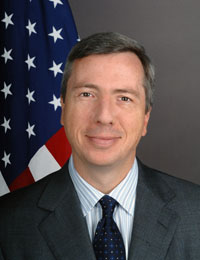

Contractors, government relationship feeling the impact of cutting-edge technology, resulting in potentially cheaper and more efficient manufacturing.
Tractor beams, holodecks, lethal robots and warp speed might sound more at home in a science fiction story, but these creations are very much a part of reality.
These real world advances also can mean cutting-edge intelligence and defense, and streamlined manufacturing in the future, as long as the government is willing to “go back to the future,” said Randall Fort, director of programs security at Raytheon.

“When you think about some of the technologies — transparent electronics, robotics, nanoionics, straintronic spin neurons, graphene nanoelectronics — I just sound like a made up a bunch of words. Those are all real things being done in real labs, in real companies and will change our world in ways that we can’t imagine in the years to come,” Fort said. “I think part of the challenge for government will be to understand that a lot of their legacy, bureaucratic procedures and processes, and rules and regulations … are simply going to need to be fundamentally realigned and rethought and rearticulated in order to keep up with the scale, the pace and the capabilities that these new technologies have to offer.”
Fort, a former assistant secretary of State for intelligence and research, is co-leading the innovation track during the Intelligence and National Security Summit, scheduled for Sept. 9-10 in the District.
While there are no hoverboard demonstrations or transporter trips scheduled for the presentation, Fort said it was a challenge to narrow down what sort of demonstrations could be shown thanks to the range of technologies already on the market today and those in development.
Fort said one such example is an airplane that will be outfitted with a three-dimensional printer and will be able to print out missiles on board and shoot either offensively or defensively.
Fort said technologies such as “3-D printing, autonomous systems, virtual reality, Internet of things, they are astonishing just in and of themselves and the capabilities that they will bring.”
But it is anyone’s guess what will happen as those capabilities merge, he added.
“There will be new insights that will be simply unimaginable until those different capabilities are mixed together.”
What this can mean for industry, Fort said, is cheaper and more efficient production.
Leading defense contractors are investing heavily in research and development of 3-D printing, Fort said. The printing style has zero waste because only the precise amount of material for each object is needed, and it lets a developer create shapes and forms and sizes that haven’t been able to be produced, like drilling a perfect 90-degree angle.
“There will be staggering efficiencies that will come about which will mean government contractors will be able to deliver more value to government customers at faster rates because it’s much quicker to 3-D print things than to have to go through the normal manufacturing process, it’ll be cheaper,” Fort said. “So there will be a number of benefits I think coming out of that.”
Likewise the acquisition process “will need to be more agile and have shorter time frames,” to keep up with innovation, Fort said.
“Legislatively, Congress is spending a lot of time talking about acquisition reform, but I think the private sector as well as some of the government agencies are going to need to be working very hard to make sure legislators have all the information of what these technologies are and their implications,” he said. “I think the government has demonstrated the ability to move with great agility and great speed when the circumstances were right.”
Stealth programs several decades ago, such as the B-2 Stealth Bomber and SR-71 Blackbird aircraft projects, were “turned around quickly,” long before the existence of the computers and other technology available today.
“Perhaps it’s a matter of the government kind of going back to the future, going back to some of their earlier roots of special programs and studying those procedures and migrating those forward into the 21st century,” Fort said. “I think the history is there if they choose to learn from it.”
But it’s also important that industry educates itself on the nature of innovation, Fort said. People need to be presented with “the art of the possible,” Fort said. They need to be thinking about the realities of technologies, their impacts on business both in the immediate and long term.
“This is about planting seeds,” Fort said. “I don’t think there’s ever not a good time to talk about innovation and some of these technologies. They’re changing so rapidly. If I were to come back in three months or six months, we would be talking about something that’s maybe 50 percent, 60 percent even 100 percent better, faster, cheaper, smaller, something along those lines. Our understanding, our comprehension of these technologies, lags behind the reality of the technology change. At any point where we can have these conversations and bring them to people’s attention I think that’s probably a good thing.”
Read more interviews with other experts from the Intelligence and National Security Summit here.
Copyright © 2025 Federal News Network. All rights reserved. This website is not intended for users located within the European Economic Area.

